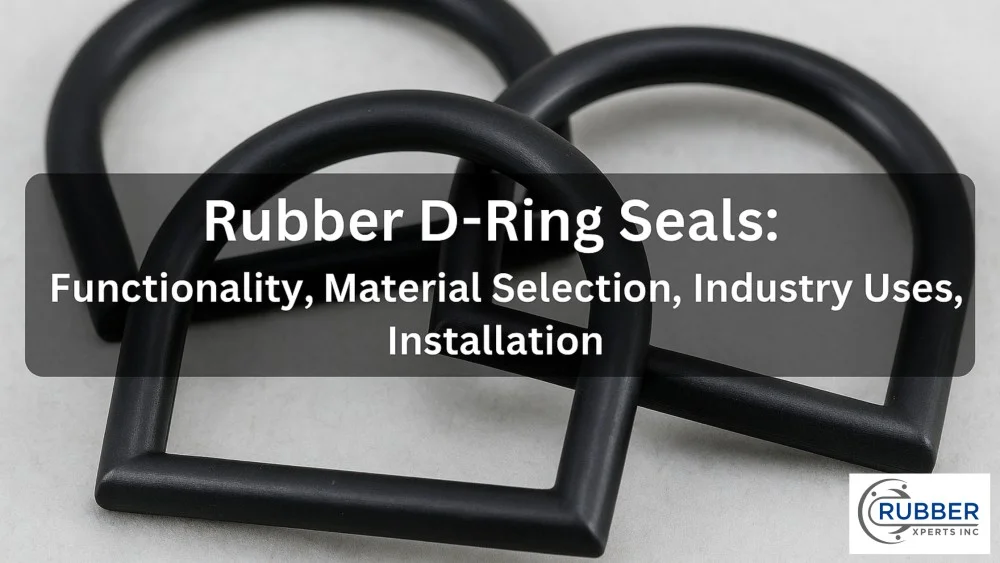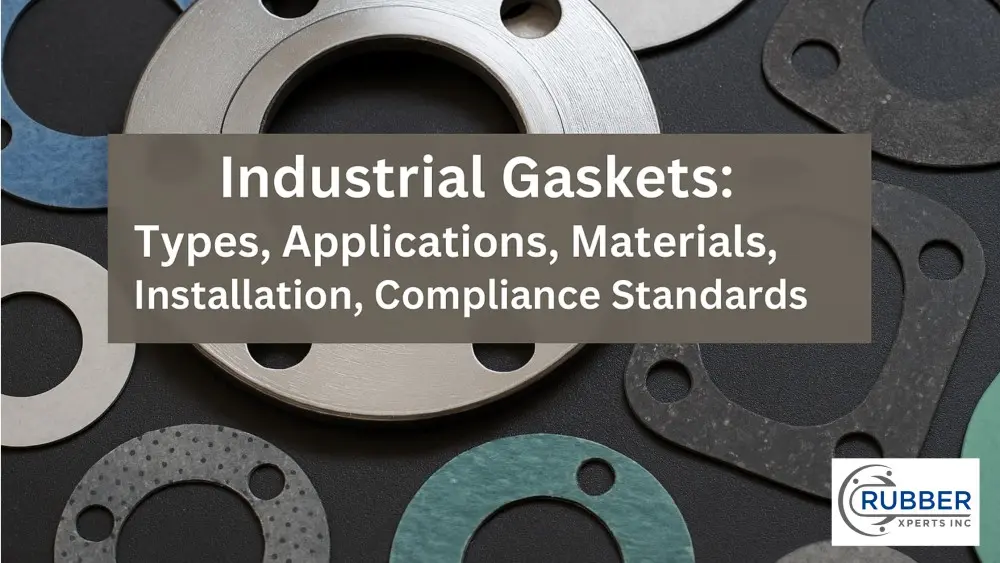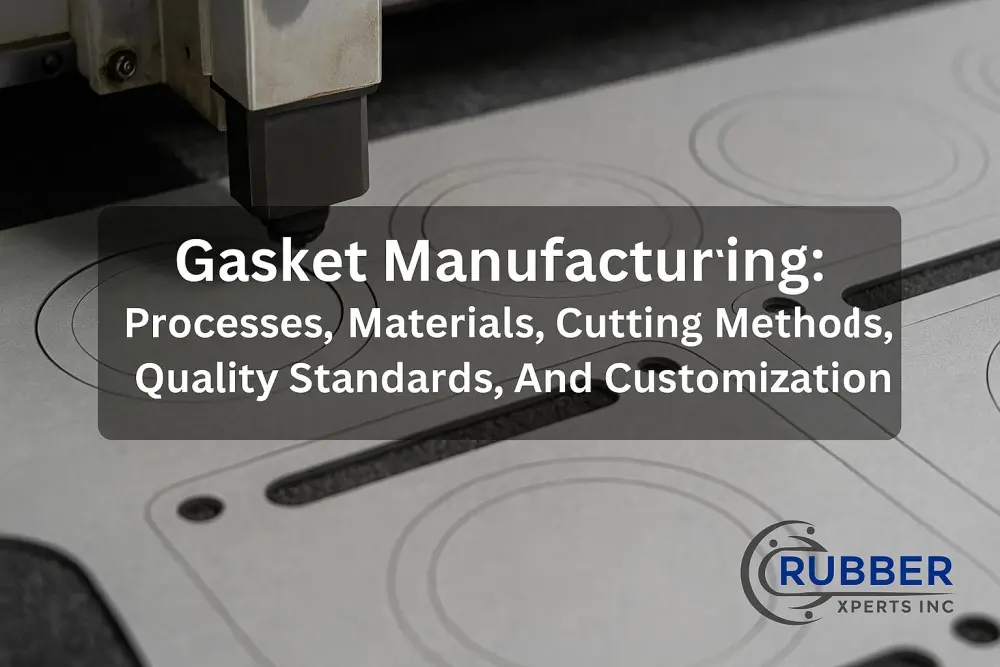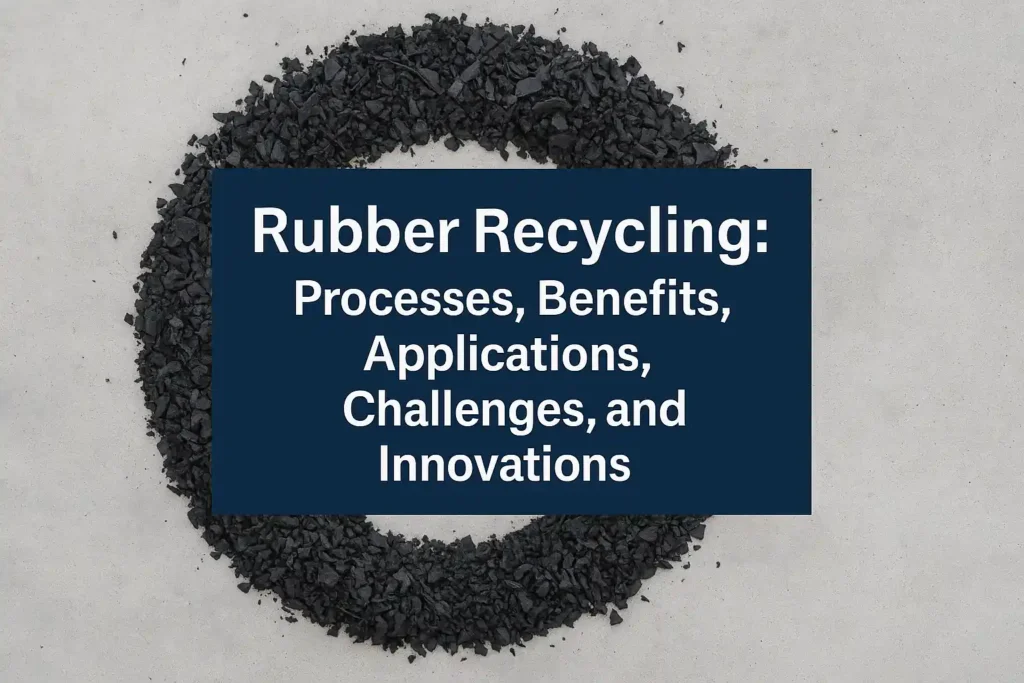Gasket manufacturing ensures the reliability of industrial systems by producing components that prevent leaks, maintain pressure boundaries, and isolate fluids. This reduces mechanical wear, minimizes failure risks, and keeps demands in high-pressure, high-cycle environments.
The processes of gasket manufacturing are templating and design, material selection, fabrication and finishing. Each phase contributes to dimensional accuracy, material stability, and functional sealing.
The materials used in gasket production include natural rubber, silicone rubber, neoprene, cork, and compressed non-asbestos. Material choice defines durability across varied gasket applications.
The cutting methods of gasket manufacturing are rotary die cutting, kiss cutting, press die cutting, waterjet cutting, and laser cutting. These processes enable the production of gaskets with clean edges and complex geometries.
The methods of gasket production include Templating and Design, Material Selection, and Fabrication and Finishing. Each method ensures the gasket meets functional, dimensional,
and application-specific sealing requirements in engineered sealing systems.
The quality standards of gasket manufacturing are ASTM, ISO, and FDA/NSF certifications. These guidelines ensure compliance with global safety and reliability benchmarks.
The customization options of gasket production include material selection, thickness and size, shape and design, and surface treatments. These features support custom gasket fabrication tailored to equipment-specific constraints.
What Is Gasket Manufacturing?
Gasket manufacturing is a gasket production process that creates industrial sealing components used to form a compression seal between mating surfaces in mechanical systems.
This process involves the manufacture of sealing parts, such as gaskets, washers, and rings, that serve as mechanical seals in engines, pipelines, machines, and industrial equipment. These components prevent the escape of fluids or gases under varying pressure and temperature conditions.
The evolution of gasket technology has introduced precision in design, material science, and cutting methods, improving the reliability of engineering sealing products across industrial sectors. The field covers gasket design basics, gasket fabrication overview, and integration into industrial sealing systems.
This section introduces the stages that follow: the gasket production process, material types, cutting techniques, quality assurance standards, and custom specifications that shape modern gasket solutions.
What Are The Processes Of Gasket Manufacturing?
The processes involved in gasket manufacturing are templating and design, material selection, fabrication, and finishing. Each process addresses a core aspect of the gasket production process, from blueprint creation to material matching and final shaping.
The processes involved in gasket manufacturing are explained below:
Templating And Design
Templating and design are the initial phases of the gasket manufacturing process. It defines the shape, dimensions, and tolerance requirements of the gasket based on the sealing environment and application. This step translates mechanical and sealing specifications into a digital or physical model used for production.
The process begins with engineering drawings or CAD models, which outline all dimensional parameters and performance demands. The mechanical assembly, surface conditions, bolt load, and fluid type inform these designs.
For sheet gasket production, designers convert these models into cutting files compatible with automated gasket production systems. In manual gasket fabrication, templates are traced directly onto sheets using printed stencils or metal dies.
Custom gasket forming begins with creating templates that match complex flange geometries or irregular sealing zones. When tolerances are tight, the precision cutting methods are calibrated based on the template’s geometry.
Templates support both die cutting for gaskets and gasket molding processes, ensuring dimensional accuracy and precision. Templating also controls the layering structure for the gasket lamination process when multiple materials are bonded. This phase is critical for reducing failure rates in industrial sealing systems by defining precise cutting paths, material zones, and mechanical fits.
Material Selection
Material selection is the process of choosing the most suitable substance for a gasket based on its chemical compatibility, thermal resistance, pressure limits, and mechanical behavior. This step ensures the gasket maintains a compression seal under operational stress.
The process begins by evaluating the sealing environment, including fluid type, temperature, and pressure conditions. Based on these variables, engineers consult material databases and industry-specific specifications such as ASTM or ISO.
Next, the decision is made between elastomers, fibers, cork, or metallic materials. In sheet gasket production, large rolls or sheets are selected, then inspected for uniformity in thickness and density. In custom gasket forming, layered or composite materials are chosen for their multi-functional performance.
For automated gasket production, materials are loaded into machines with digital controls for speed, pressure, and feed rate. In manual gasket fabrication, sheets are aligned and clamped before marking.
When materials require bonding, the gasket lamination process applies adhesives or heat to combine layers. This step ensures uniform expansion under load. Some applications also require molded materials processed through the gasket molding process for shaped seals. This material matching stage directly determines the durability, efficiency, and lifecycle of the mechanical seals in service.
Fabrication And Finishing
Fabrication and finishing is the phase where selected materials are shaped into usable industrial sealing components through precise cutting, molding, bonding, and surface conditioning. This stage finalizes the gasket production process, ensuring the output meets dimensional, structural, and sealing requirements.
The die-cutting for gaskets method involves pressing pre-shaped steel dies into sheets to produce gaskets with consistent geometry. A press applies high force on the die, cutting clean outlines through the material. This process is vital in automated gasket production for high-volume manufacturing with minimal variance.
The gasket molding process is used when sealing components require complex shapes or integrated features. Uncured rubber is loaded into custom-machined molds and subjected to controlled heat and pressure. Once cured, the molded part is ejected and trimmed to the desired shape. This technique supports custom gasket forming for demanding industrial configurations.
Precision cutting methods such as CNC, waterjet, or laser systems follow CAD templates to achieve fine tolerances. Material is held in position while a computer-guided cutter executes the path with high accuracy. This method is used in both manual gasket fabrication and digitally driven production systems.
The gasket lamination process creates multi-layer gaskets by bonding different material sheets. Layers are pressed with adhesive or heat to form a unified sheet with combined mechanical and chemical properties. These laminated materials are then cut into final shapes using standard or digital gasket cutting techniques.
Fabrication and finishing are the technical core of engineering sealing products, linking design and material science to functional mechanical seals.
What Materials Are Used In Gasket Manufacturing?
The materials used in gasket manufacturing are natural rubber, silicone rubber, neoprene rubber, neoprene sponge, cork, and compressed non-asbestos. These materials form the basis of sheet gasket production, custom gasket forming, and gasket molding processes, supporting durability and mechanical stability in engineering sealing products.
The materials used in gasket manufacturing are as follows:
Natural Rubber
Natural rubber is an elastomer derived from the latex of the Hevea brasiliensis tree. It is classified as a non-synthetic polymer with high elasticity and low permanent deformation under compression. The material offers moderate resistance to water, alcohols, and organic acids, but degrades when exposed to oils, ozone, or elevated temperatures.
In gasket manufacturing, natural rubber is used in the production of sheet gaskets for systems that require high rebound and flexibility. Its elongation under load supports manual gasket fabrication where adaptive sealing around irregular surfaces is needed. Applications include air seals, low-pressure water pipelines, and vibration isolation in mechanical assemblies.
Silicone Rubber
Silicone rubber is a synthetic elastomer composed of silicon, oxygen, carbon, and hydrogen. It maintains stability across extreme temperature ranges from –60°C to 230°C and exhibits high resistance to UV radiation, ozone, and oxidation. It is chemically inert and maintains flexibility without material fatigue over extended cycles.
In gasket manufacturing, silicone rubber is used in custom gasket forming for environments that involve thermal fluctuations and require electrical insulation. It is used in automated gasket production for sealing components in medical devices, food processing systems, and electronic enclosures requiring non-reactive and temperature-stable mechanical seals.
Neoprene Rubber
Neoprene rubber is a synthetic elastomer made from polymerized chloroprene. It provides resistance to moderate oils, greases, aging, ozone, and various weather conditions. The material exhibits balanced mechanical strength, compression resistance, and thermal stability over a temperature range of –40°C to 120°C.
In gasket manufacturing, neoprene rubber is utilized in the production of sheet gaskets and for die cutting, where both resilience and environmental durability are required. It is applied in HVAC systems, industrial enclosures, and automotive sealing tasks that demand resistance to weathering, vibration, and mild chemicals.
Neoprene Sponge
Neoprene sponge is a closed-cell variant of neoprene rubber characterized by its compressibility, lightweight structure, and water resistance. It contains gas-filled cells that enhance cushioning and insulation without absorbing fluids. The material operates effectively between –40°C and 100°C.
In gasket manufacturing, neoprene sponge is used in custom gasket forming for applications requiring flexible seals that conform to uneven surfaces. It supports manual gasket fabrication in enclosures, access panels, and HVAC flanges where shock absorption, sound damping, and environmental sealing are required.
Cork
Cork is a natural, lightweight material harvested from the bark of the cork oak tree. It has a cellular structure that enables it to be compressible, recover, and resist fluid flow. Cork withstands temperatures ranging from –20°C to 120°C and is chemically resistant to oils, fuels, and lubricants when combined with rubber.
In gasket manufacturing, cork is used in gasket lamination processes where it is bonded with elastomers to produce hybrid sealing materials. It is applied in sheet gasket production for engines, compressors, and hydraulic systems, particularly in oil-retaining gaskets that demand high torque retention and vibration control.
Compressed Non-Asbestos
Compressed non-asbestos is a synthetic composite made from aramid fibers, fillers, and elastomeric binders. It was developed to replace asbestos materials while maintaining resistance to heat, pressure, and chemicals. The material withstands temperatures up to 400°C and pressures exceeding 100 bar, depending on formulation.
In gasket manufacturing, compressed non-asbestos is used in die cutting for gaskets and automated gasket production for high-performance sealing applications. It is selected for pipelines, flanges, and industrial machinery exposed to steam, oils, or corrosive substances where mechanical seals must remain stable under thermal cycling and load variations.
What Are The Cutting Methods Of Gasket Manufacturing?
The cutting methods used in gasket manufacturing include rotary die cutting, kiss cutting, press die cutting, flatbed die cutting, knifeless die cutting, waterjet cutting, and laser cutting. Each method supports specific material types, production volumes, and tolerance requirements, which in turn impact the efficiency and accuracy of the gasket cutting techniques used.
The cutting methods used in gasket manufacturing are explained below:
Rotary Die Cutting
Rotary die cutting is a high-speed gasket cutting technology that uses a cylindrical die mounted on a rotating press to cut gasket materials in continuous rolls. The method supports high-volume production with consistent repeatability and tight tolerances.
The process begins by feeding rolled material through rotating dies with pre-shaped cutting blades. As the cylinder turns, the die presses into the material, executing clean, uniform cuts at high speed. The continuous rotation enables fast throughput and minimizes material handling.
This precision gasket cutting method is applied in automated gasket production using flexible materials, such as rubber, foams, and composites. It is used to produce large batches of flat seals for automotive, HVAC, and industrial equipment, where accuracy and efficiency are critical in gasket blanking methods.
Kiss Cutting
Kiss cutting is a gasket cutting technology that partially cuts through the gasket material without slicing the backing layer or liner. This method is used when gaskets are produced with adhesive backing for easy peel-and-apply installation.
The process utilizes a rotary or flatbed die that is calibrated to penetrate only the gasket layer. The die applies controlled pressure to cut the top layer while preserving the backing sheet. Cut gaskets remain attached to the liner, allowing precise alignment during application.
Kiss cutting is implemented in rotary cutting systems or CNC cutting for gaskets involving adhesive-backed foams, rubber sheets, or laminated gasket materials. It is commonly used in electronics, automotive, and medical devices where pre-applied adhesive and fast assembly are required.
Press Die Cutting
Press die cutting is a die-cutting method that uses a hydraulic or mechanical press to stamp gasket shapes from sheet materials using a fixed, steel rule die. It is one of the earliest and most widely used gasket blanking methods for medium-volume production.
The process begins with material sheets placed on a cutting bed. A pre-formed steel die, shaped to the gasket profile, is pressed down with controlled force. The die cuts through the material completely, creating clean, repeatable outlines.
Press die cutting is used in both manual gasket fabrication and automated gasket production for rubber, fiber, cork, and composite materials. It supports the production of flat, non-adhesive gaskets with moderate precision and is commonly applied in industrial machinery, pump housings, and enclosures.
Flatbed Die Cutting
Flatbed die cutting is a gasket cutting technology that uses a vertically moving press and a flat cutting surface to shape gaskets from sheet materials using steel rule dies. This method supports thicker materials, lower production speeds, and custom geometries.
The process starts with positioning the material sheet on a flat surface. A steel die, mounted on a fixed platen, is lowered vertically onto the material. Uniform pressure is applied across the surface, allowing complete cuts through the gasket layer.
Flatbed systems are preferred in hand-cutting operations and low-to-medium volume custom gasket forming, where flexibility in size, shape, and material thickness is required. It is widely used for cutting fiber sheets, sponge rubber, and cork in HVAC, fluid control, and sealing flanges.
Knifeless Die Cutting
Knifeless die cutting is a precision gasket cutting method that replaces traditional steel rule dies with digital or mechanical cutting tools, eliminating the need for physical blades. This process enhances flexibility in custom production and reduces tooling costs.
The method uses CNC cutting for gaskets, where a programmed machine guides a sharp-edged tool or wheel along the gasket template. The tool applies sufficient force to separate the material without using fixed dies. Cutting parameters are adjusted digitally for each job.
Knifeless die cutting is applied in gasket blanking methods where frequent design changes or short production runs are required. It supports a wide range of materials, including rubber, foam, composites, and laminated sheets, particularly in prototyping, aerospace, and electronics applications demanding tight tolerances and design adaptability.
Waterjet Cutting
Waterjet cutting is a gasket cutting technology that uses a high-pressure stream of water, mixed with abrasive particles, to cut through gasket materials without heat. This method maintains material integrity, especially in thermally sensitive applications.
The process begins by placing the gasket material on a sealed cutting bed. A computer-guided nozzle directs a fine stream of water at pressures exceeding 60,000 psi. The CNC cutting for gaskets system controls the movement path based on the digital gasket template, allowing accurate, smooth cuts.
Waterjet cutting is ideal for thick or multi-layered materials, including rubber, plastics, and compressed non-asbestos. It is used in precision gasket cutting for industries requiring clean edges and no heat-affected zones, such as food processing, medical equipment, and aerospace sealing components.
Laser Cutting
Laser cutting is a precision gasket cutting method that uses a focused beam of light to cut gasket materials with high accuracy and speed. This contactless process reduces mechanical stress and enables detailed contouring.
The process begins with uploading the gasket design into a CNC cutting for gaskets system. The laser source generates a concentrated beam directed by mirrors and lenses. The beam melts, burns, or vaporizes the material along the programmed path. A fume extraction system removes gases and debris.
Laser cutting enables the automated production of gaskets using thin rubber, PTFE, silicone, and fiber-based sheets. It is applied in electronics, medical, and micro-mechanical systems where tight tolerances, fine features, and clean edges are required in gasket blanking methods.
What Are The Quality Standards Of Gasket Manufacturing?
The quality standards for gasket manufacturing are ASTM Standards, such as ASTM D2000, ASTM F104, and ASTM D395; ISO Standards, including ISO 9001, ISO 2230, and ISO 3601-1; and FDA and NSF Certifications. These standards define performance benchmarks, testing procedures, and regulatory compliance required for producing safe and reliable engineering sealing products.
The quality standards for gasket manufacturing are explained below:
ASTM Standards
ASTM standards are structured technical documents developed by ASTM International to define material properties, testing protocols, and classification systems for industrial products.
ASTM standards in gasket production are ASTM D2000, ASTM F104, and ASTM D395. The standards applied in gasket manufacturing support gasket material compliance, ensure manufacturing consistency, and establish performance testing for gaskets under mechanical and thermal stress.
ASTM standards in gasket production are:
- ASTM D2000: This standard establishes a classification system for rubber materials based on their physical properties, including tensile strength, elongation, and heat resistance. It is used to specify material grades in elastomer-based gaskets.
- ASTM F104: This standard establishes a numeric system to classify non-metallic gasket materials. It defines properties including compressibility, recovery, fluid resistance, and thickness tolerances.
- ASTM D395: This standard outlines test methods for determining the compression set in rubber materials under static conditions. It assesses the permanent deformation retained after the compressive force is removed.
ISO Standards
ISO standards are international specifications published by the International Organization for Standardization to regulate quality systems, material behavior, and product design across global industries.
ISO standards in gasket production are ISO 9001, ISO 2230, and ISO 3601-1.ISO standards. These standards reinforce gasket quality assurance, enhance quality control in gasket production, and align output with global sealing product certifications.
ISO standards in gasket production are:
- ISO 9001: Quality Management Systems. This standard establishes the framework for maintaining consistent production processes and preventing defects. It creates formal controls that support manufacturing consistency in gasket plants.
- ISO 2230: Storage Guidelines for Elastomeric Seals. This standard establishes the storage life limits and environmental conditions for rubber-based gasket materials. It addresses degradation caused by temperature, humidity, and UV exposure.
- ISO 3601-1: Dimensional Requirements for O-Rings. This standard defines exact tolerances, cross-sectional ranges, and diameter classifications for O-ring gaskets. It is applied in precision gasket cutting and ensures interchangeability across sealing applications.
FDA And NSF Certifications
FDA and NSF certifications are regulatory standards confirming that gasket materials meet safety requirements for use in food, beverage, medical, and potable water systems. These approvals establish sealing product certifications based on non-toxicity, chemical resistance, and performance stability in hygienic and consumable environments.
The U.S. Food and Drug Administration (FDA) governs gasket safety through CFR Title 21 regulations. These regulations mandate that materials in contact with food or drugs remain chemically stable and inert. These requirements ensure gasket material compliance in pharmaceutical manufacturing, food processing equipment, and laboratory systems.
According to a study by the U.S. Food and Drug Administration’s Center for Food Safety and Applied Nutrition titled “Migration Testing and Elastomeric Seal Safety in Food Equipment Applications” (2020), FDA-compliant gaskets reduced contamination incidents by 67% compared to non-compliant materials in high-contact environments.
NSF certification, issued by the National Sanitation Foundation, evaluates gasket integrity in water systems. It tests for leaching, thermal resistance, and cleaning chemical exposure to protect public health in applications like water filtration, dispensing systems, and food handling stations.
What Customization Options Are Available For Gasket Manufacturing?
The customization options available for gasket manufacturing include material selection, thickness and size, shape and design, as well as coatings and surface treatments. These options allow adaptation of engineering sealing products to specific operational demands, mechanical interfaces, and environmental exposures.
The customization options available for gasket manufacturing are explained below:
Material Selection
Material selection in gasket customization refers to the process of choosing the exact gasket material to match application-specific variables such as chemical exposure, temperature range, and mechanical load. It defines the base composition for specialized sealing components used in systems where performance failure is not permissible.
Material selection is critical in gasket specification matching because it determines sealing durability, compatibility, and compression behavior. Rubber gasket materials are evaluated for resistance to fluids, gas permeability, thermal cycling, and aging. This process enables the production of made-to-order gaskets and engineered gasket designs that meet the physical and chemical demands of their intended use.
Thickness And Size
Thickness and size customization refers to the adjustment of gasket dimensions to achieve a precise interface between mating surfaces. This process defines the vertical compression range and surface coverage required for sealing efficiency in varied assemblies. It is applied in both prototype gasket production and full-scale runs for precision-fit gaskets.
Controlling thickness and size is necessary to prevent compression loss, uneven loading, and seal displacement. Proper dimensional tuning supports custom gasket design by aligning gasket geometry with surface tolerances, bolt loads, and housing structures. This ensures functional, tailored gasket solutions for static and dynamic sealing environments.
Shape And Design
Shape and design customization define the geometric profile and layout of a gasket based on the sealing surface it interfaces with. This includes circular, rectangular, and irregular forms, along with internal features such as holes, tabs, or alignment grooves. The process relies on digital modeling and bespoke gasket engineering to meet precise sealing layouts.
Shape accuracy is vital for achieving surface contact, pressure retention, and directional sealing. O-Ring gaskets are a common example of this, where cross-sectional precision and profile uniformity ensure proper compression in radial and axial directions. Correct design supports engineered gasket designs by matching load paths and flange geometries in static and moving joints.
Coatings And Surface Treatments
Coatings and surface treatments involve applying functional layers or chemical modifications to the gasket surface to enhance its sealing behavior, environmental resistance, or installation performance. These treatments include anti-stick coatings, thermal barriers, chemical sealants, and surface texturing for grip. They are used in gasket customization options to prepare materials for application-specific sealing conditions.
Surface treatments are important for improving gasket interaction with flanges and system media. They reduce installation friction, prevent bonding to surfaces, and extend service life in corrosive or high-friction environments. In tailored gasket solutions, coatings ensure that custom gasket designs remain stable under repeated use, exposure cycles, or non-lubricated assemblies.
What Are The Applications Of Custom Gaskets?
The applications of custom gaskets include Aerospace, Automotive, Chemical Processing, Construction, Electronics, Food and Beverage, Marine, Oil and Gas, Pharmaceutical, and Power Generation. These industries require specialized sealing components that conform to precise performance, safety, and regulatory criteria.
The applications of custom gaskets are:
- Aerospace: Custom gaskets are used in aircraft engines, fuselage assemblies, and hydraulic systems. Materials must endure pressure changes, vibration, and temperature fluctuations.
- Automotive: Gaskets are used in various components, including engines, exhaust systems, transmissions, and brake assemblies. They must resist fuel, oil, and thermal stress while maintaining fit during motion.
- Chemical Processing: Custom gaskets are applied in pumps, flanges, and chemical containment systems. They must resist aggressive solvents, acids, and high-temperature fluids.
- Construction: Gaskets are found in HVAC systems, concrete joints, and structural seals. They handle thermal cycling, water intrusion, and vibration.
- Electronics: Used in enclosures, connectors, and control systems, gaskets block dust, moisture, and electromagnetic interference. Engineered gasket designs protect sensitive circuitry.
- Food and Beverage: Sealing components in this sector must comply with hygienic and contact safety regulations. Gaskets are applied in mixers, piping, and filling systems. Gasket customization options align with FDA and NSF material standards.
- Marine: Marine gaskets seal engine parts, hull penetrations, and on-deck hardware. Exposure to saltwater, vibration, and fluctuating pressure demands rugged materials.
- Oil and Gas: Gaskets are installed in wellheads, pipelines, and separators. High-pressure, high-temperature resistance is mandatory. Custom sealing systems enhance operational safety and reduce maintenance frequency.
- Pharmaceutical: Gaskets are used in sterile processing equipment, reactors, and containment units. Materials must resist steam, cleaning agents, and reactive compounds.
- Power Generation: Found in turbines, heat exchangers, and valve systems, gaskets endure thermal cycling and mechanical stress. They maintain seal performance under vibration and high-load environments.
Why Gasket Manufacturing Is Important?
Gasket manufacturing is important because it enables the production of specialized sealing components that prevent fluid and gas leakage in critical industrial systems. It supports the integrity of mechanical assemblies under thermal, chemical, and pressure-related stress.
Without controlled gasket production, sealing failures lead to increased maintenance demands, operational risks, and system inefficiency. Through custom gasket design, manufacturers ensure compatibility with a wide range of equipment, tolerances, and material requirements.
Precision in gasket fabrication directly contributes to safety, energy conservation, contamination control, and regulatory compliance across various sectors, including the medical, aerospace, and petrochemical industries. The process is foundational to achieving reliable, long-term system performance.
What Material Makes The Best Gasket?
Compressed non-asbestos makes the best gasket material for most industrial applications due to its resistance to heat, pressure, oils, and aggressive chemicals. It maintains seal integrity across a wide temperature range and performs under cyclic loading without permanent deformation or loss of compression.
According to a study by the University of Cambridge, Department of Materials Science, titled “Comparative Performance of Elastomeric Gasket Materials in Industrial Sealing” (2021), compressed non-asbestos gaskets increased sealing durability by 38% and retained over 90% compression resilience after 1,000 thermal cycles, outperforming natural rubber, neoprene, and cork-based alternatives.
What Are The Considerations For Gasket Design?
The primary considerations for gasket design are material compatibility, load distribution, sealing surface geometry, operating conditions, and thickness tolerance. These factors determine whether a gasket maintains effective sealing under real-world conditions without premature failure.
Each element influences the behavior of the gasket under compression, thermal expansion, and chemical exposure. Engineered gasket designs require exact material-property matching with operating temperature, pressure, and fluid type. Incorrect thickness or hardness cause blowout, over-compression, or uneven stress.
Where To Get Customized Gaskets?
To get customized gaskets, sourcing must focus on precision manufacturing capabilities, material range, and compliance with industry standards. Suppliers must offer prototype gasket production, custom gasket design, and support for sector-specific certifications to ensure operational reliability and seal performance.
Gasket manufacturers that specialize in made-to-order gaskets provide full integration of design, cutting, and material selection based on engineering requirements. Look for production partners with experience in bespoke gasket engineering, verified quality systems, and the ability to deliver tailored gasket solutions across multiple industries.





